Chain reaction of increasing class polarization
Capitalism has been compared to a pyramid scheme.
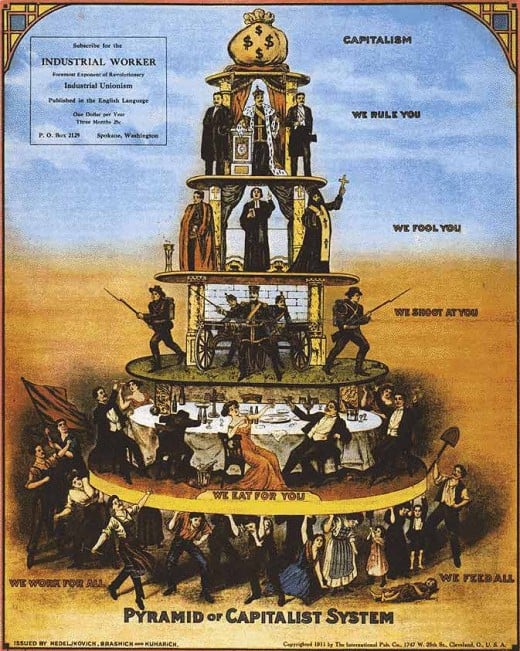

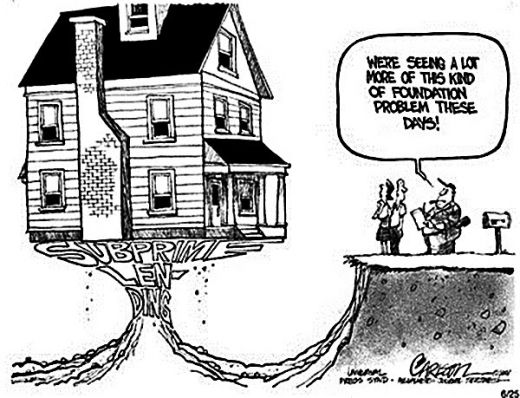
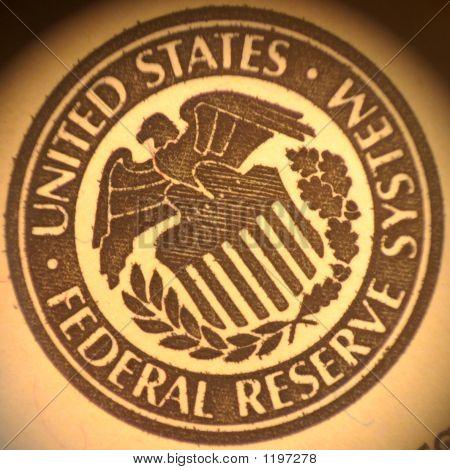
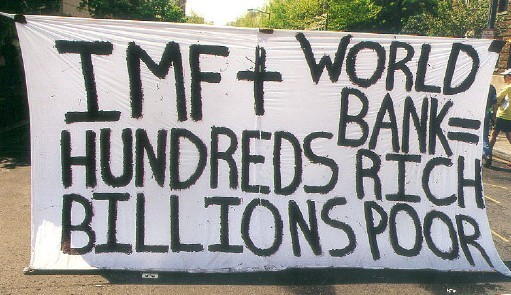
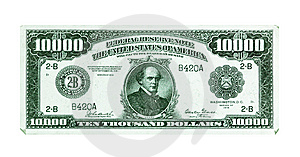
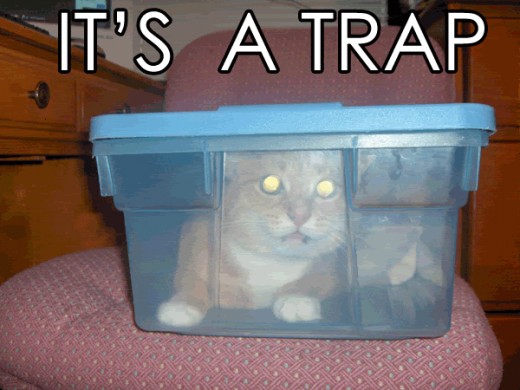
The future of America's free market economy
To gauge the future of the free market economy, we have to track its evolution through history to the present and project from there. The present state of the economy is the result of a long chain of historical events and decisions that were geared to maximizing profit. This maximizing profit came with a dark side; the increase of class polarization and all the ills that go along with it, such as obscene levels of opulence in the face of grinding poverty in the richest country on the planet. It came with a maximum level of freedom while the poor suffered the highest rate of internment on the planet. The free market economy swept the world and brought to ruin through war and imperialism, many undeveloped countries, which were mined for resources and cheap labor. The market has had its ups and downs repeatedly in history and the free market economy has been able to reverse the down-turns in the past. But today, we see a different circumstance that is the result of past fixes running their course and playing out. Now the free economy has run out of fixes and impoverishment is running amok in the richest country. We now explore the series of events that were laid down in the context of history that has led to the current crisis and its ultimate future.
The roots of the current crisis and the future of the free market economy was were laid during the days of the American Revolution, which in essence was a bourgeois revolution in breaking away from the rule of aristocracy and budding bourgeois capitalism in Britain. So called inalienable rights were born in the bid to break away from British imperialism; the right of the freedom of association, the equality of all men, the pursuit of happiness, representation in a government of representatives in the form of a republic and so forth. A further act was needed for generate true freedom, and that was a clean break from the pound sterling. A new currency had to be developed and this at first was solidly based on the gold standard which meant that every dollar was backed by gold and was even made from gold and silver. The money supply was tied to the gold and only so much could be in circulation as a result as the quantity of gold and silver was relatively fixed. New money came with the finding of new gold such as in the gold rush days of California and Alaska. In the early days, class distinctions were not as sharp as they became and were a far cry from what they are now.
Then as now, the elite of many countries traded, warred and interfered with the affairs of other countries. This still goes on today in the later days of imperialist adventurism that seeks more resources, cheap labor and territory. This is done either through trade blocks, agreements or through an act of war. The free market economy unfortunately has become a victim of such maneuverings. This is accomplished through off-shore hiring, free trade agreements, off-shore investment and the like. The result of such activity is to destroy manufacturing and jobs at home, driving up poverty levels and lowering job standards. Combined with the speculation of floating currency, this is a formula for catastrophe for the average worker who weathers the anarchy of capitalism. The worker is reduced to the level of being the holder of a commodity; his/her laboring ability.
It took the civil war in the US during the mid 19th century to encourage the development of a currency that was not backed by anything except the promise of the currency producer. As banks would not fund the ventures of civil war as it was seen as too great a risk, Abraham Lincoln developed and used the green-back that became the promissory currency that had no gold backing and no real collateral to support it. The idea worked and the North ended up winning the civil war and taking the spoils of the south. The so called liberation of the slaves was nothing more than tapping a new market for cheap labor. Chattel slavery was exchanged for wage slavery, at least for those who could escape post civil war grinding poverty to find low paying jobs in the north. The important development here though, that would have far reaching consequences is the foundation and further use of a fictitious value currency; i.e., a currency/universal commodity fetish not founded on anything but a promise; that could be used as an universal commodity.
Production for use is the primary goal of any civilization so that the members thereof can live in the assurance of the necessities of life to carry them through the lean times. Lean times can come through the aegis of dry spells, disasters and/or winter. With production for use in such a climate, must come surplus production and value to hold over for lean times. This is the natural context of over production. Over production can also be used as a surplus for trade for items not available in the region where surplus value is created of a certain commodity. This then sets the field for the interaction of economies that specialize in various surplus values.
Supply and demand determines the value of anything that is a commodity. If there is little demand and a lot of surplus value, then the relative value of that something falls in relation to other fixed values, such as a standard value. If there is a lot of demand and little supply, the relative value rises instead. Now this surplus can be manipulated and is to a great degree in order to raise relative value. So instead, we see the contradiction of a lot of surplus value and high relative value simultaneously. The free market engaged in such activities is not really free at all as commodity price fixing becomes the norm rather than commodities rising and falling to the true relative value. The result of such practice is the risk of market collapse when fictitious value is suddenly removed and the value collapses accordingly toward its real level. With over production of commodities as a reality, the price can fall to a level approaching zero. From its inception and into the 20th century, market manipulation has become the norm that has brought with it the risk of collapse and massive poverty for most and great wealth for a few.
Mechanization and the multiplication of productive power began early in the context of the industrial revolution. This has put the laborer on a continuous learning curve, just to remain in the employ by selling the only commodity they have; the ability to work. From the first power loom to the modern robotic assembly line, this has been the norm where labor power has been amplified thousands of times over so that a handful of workers can now produce the same amount of surplus value as an army of laborers did in the past. The people squeezed out with each advance had to retrain, fall into the army of the unemployed or become criminals. This is but one path of making profits by increasing productivity. This creates the problem of so much over production that the unit commodity becomes almost worthless. This in itself harms profitability.
The crisis of overproduction results in such an abundance that the glut sits idle, even though the army of the unemployed could use the surplus. Even though it is next to worthless in relative value due to its super abundance, the market is often manipulated to keep prices artificially high. In some circumstances, overproduction is destroyed, such as food that "has no market" in order to keep prices up. Sometimes commodities are passed on through a line of investment with each round of investment increasing prices without adding any real value. What is added is fictitious value. There are many market manipulations that take the freedom out of the market. This trend developed with the advent of stock market speculation and tended to restrict the free market that was the hallmark of laisse faire capitalism. But as more and more business concentrated into fewer and fewer hands, the freedom of the market became more and more controlled by banks and the government.
Any new business needs requires money to get started and this usually is done on loans from a financial institute that lends on interest against collateral actual or potential. The collateral thus becomes the virtual property of the lending institute by law until the loan is paid off in full including interest, which adds fictitious value. Anyone acquiring commodities from such a company is paying for added fictitious value. The free market in such a circumstance is not so free being controlled by bankers and speculators.
The Federal Reserve and the evolution of the International Monetary fund and World Bank began over the Christmas season of 1913. The Federal Reserve was dressed to look beneficial to business and the consumer. But the Federal Reserve acted as an agency to directly control the value of the universal commodity which in turn determined the buying power of anyone in any trade. The Federal Reserve acted in such a way as to inflate or devalue currency and does so to this day with the idea of profiting from currency speculation. The free market has in many ways developed into a casino. The result of such speculation is to increase the divide between rich and poor, widening class polarization.
Cheapening of wages is accomplished by a few ways; among them having a reserve army of the unemployed, obtaining cheap labor “off-shore” in third world countries, the use of prison labor and through slavery. All of this is used to break high wages domestically and to destroy unions so that labor is without organization and representation. They are sold on the “partnership” of workers and management and told that they are part of the middle class. Nothing could be further from the truth as the proletariat has absolutely nothing in common with the exploiting bourgeoisie. Anyone who gets a salary or a wage is a worker plain and simple. The middle class is the reserve of the petite bourgeoisie and grand bourgeoisie that “own the means of production” and hire people to do the work, while they manage the work force. Although this structure looks like a free market; the worker has the freedom to work for any wage that is offered or to starve in the streets like the homeless reserve army of the unemployed who in some countries are now told to supplement their diet with rats. Meanwhile, the petite and grand bourgeoisie struggle against one another to acquire a larger share of the market. Some get eliminated and fall into the ranks of the working class; a fate that is dreaded by the real middle class. Fewer and fewer people have any real say in the market and it becomes less and less free.
The future of such a free market is dim indeed as the means of production and real wealth accrue into fewer and fewer hands. Meanwhile, the divide between the rich and the poor becomes more entrenched and increasingly polarized into extremes. From small beginnings to the ultimate end of one world corporation, the chain reaction of the collapsing free market will leave little choice under a world monopoly.








